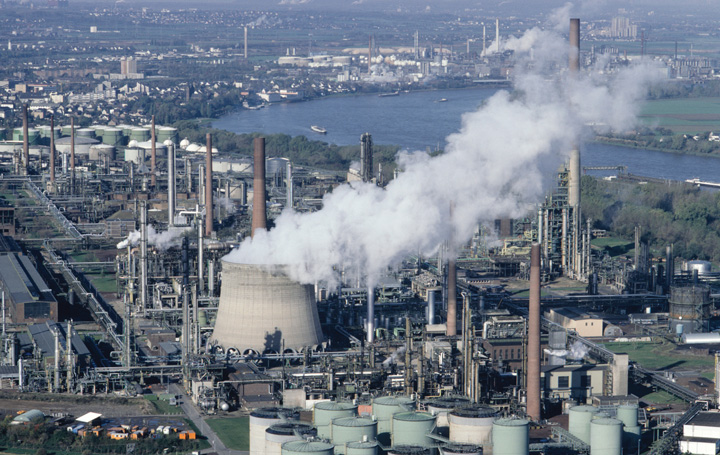This is “Society and the Environment”, section 20.3 from the book Sociology: Comprehensive Edition (v. 1.0). For details on it (including licensing), click here.
For more information on the source of this book, or why it is available for free, please see the project's home page. You can browse or download additional books there. To download a .zip file containing this book to use offline, simply click here.
20.3 Society and the Environment
Learning Objectives
- List two reasons that make the environment an appropriate topic for sociologists to study.
- Describe two of the environmental problems facing the world today.
At first glance, the environment does not seem to be a sociological topic. The natural and physical environment is something that geologists, meteorologists, oceanographers, and other scientists should be studying, not sociologists. Yet the environment is very much a sociological topic for at least five reasons. First, our worst environmental problems are the result of human activity, and this activity, like many human behaviors, is a proper topic for sociological study. Second, environmental problems have a significant impact on people, as do the many other social problems that sociologists study. Third, solutions to our environmental problems require changes in economic and environmental policies, and the potential impact of these changes depends heavily on social and political factors. Fourth, many environmental problems reflect and illustrate social inequality based on social class and on race and ethnicity: as with many issues in our society, the poor and people of color often fare worse when it comes to the environment. Fifth, efforts to improve the environment, often called the environmental movement, constitute a social movement and, as such, are again worthy of sociological study.
All these considerations suggest that the environment is quite fittingly a sociological topic, and one on which sociologists should have important insights. In fact, so many sociologists study the environment that their collective study makes up a subfield in sociology called environmental sociologyThe study of the interaction between human behavior and the natural and physical environment., which refers simply to the sociological study of the environment. More specifically, environmental sociology is the study of the interaction between human behavior and the natural and physical environment.
Environmental sociology assumes “that humans are part of the environment and that the environment and society can only be fully understood in relation to each other” (McCarthy & King, 2009, p. 1).McCarthy, D., & King, L. (2009). Introduction: Environmental problems require social solutions. In L. King & D. McCarthy (Eds.), Environmental sociology: From analysis to action (2nd ed., pp. 1–22). Lanham, MD: Rowman & Littlefield. According to a report by the American Sociological Association, environmental sociology “has provided important insights” (Nagel, Dietz, & Broadbent, 2010, p. 13)Nagel, J., Dietz, T., & Broadbent, J. (Eds.). (2010). Workshop on sociological perspectives on global climate change. Washington, DC: National Science Foundation and American Sociological Association. into such areas as public opinion about the environment, the influence of values on people’s environmental behavior, and inequality in the impact of environmental problems on communities and individuals. We will examine some of these insights after first reviewing the serious state of the environment.
To say that the world is in peril environmentally might sound extreme, but the world is in fact in peril. People are responsible for the world’s environmental problems, and we have both the ability and the responsibility to address these problems. As sociologists Leslie King and Deborah McCarthy (2009, p. ix)King, L., & McCarthy, D. (Eds.). (2009). Environmental sociology: From analysis to action (2nd ed.). Lanham, MD: Rowman & Littlefield. assert,
We both strongly believe that humans have come to a turning point in terms of our destruction of ecological resources and endangerment of human health. A daily look at the major newspapers points, without fail, to worsening environmental problems….Humans created these problems and we have the power to resolve them. Naturally, the longer we wait, the more devastating the problems will become; and the more we ignore the sociological dimensions of environmental decline the more our proposed solutions will fail.
A few facts and figures on selected issues will indicate the extent and seriousness of the environmental problem.
Air Pollution

Air pollution probably kills thousands of Americans every year and 2 million people across the planet.
© Thinkstock
We have already mentioned that air pollution is estimated to kill at least 10,000 Americans, and possibly as many as 60,000, every year. The worldwide toll is much greater, and the World Health Organization (2008)World Health Organization. (2008). Air quality and health. Retrieved from http://www.who.int/mediacentre/factsheets/fs313/en/index.html estimates that 2 million people across the globe die every year from air pollution. These deaths typically result from the health conditions that air pollution causes, including heart disease, lung cancer, and respiratory disease such as asthma. Most air pollution stems from the burning of fossil fuels such as oil, gas, and coal. This problem occurs not only in the wealthy industrial nations but also in the nations of the developing world; countries such as China and India have some of the worst air pollution. In developing nations, mortality rates of people in cities with high levels of particulate matter (carbon, nitrates, sulfates, and other particles) are 15%–50% higher than the mortality rates of those in cleaner cities. In European countries, air pollution is estimated to reduce average life expectancy by 8.6 months. The World Health Organization (2008)World Health Organization. (2008). Air quality and health. Retrieved from http://www.who.int/mediacentre/factsheets/fs313/en/index.html does not exaggerate when it declares that air pollution “is a major environmental health problem affecting everyone in developed and developing countries alike.”
Global Climate Change
The burning of fossil fuels also contributes to global climate change, often called global warming, thanks to the oft-discussed greenhouse effect caused by the trapping of gases in the atmosphere that is turning the earth warmer, with a rise of almost 1°C during the past century. In addition to affecting the ecology of the earth’s polar regions and ocean levels throughout the planet, climate change threatens to produce a host of other problems, including increased disease transmitted via food and water, malnutrition resulting from decreased agricultural production and drought, and a higher incidence of hurricanes and other weather disasters. All these problems have been producing, and will continue to produce, higher mortality rates across the planet. The World Health Organization (2010)World Health Organization. (2010). Climate change and health. Retrieved from http://www.who.int/mediacentre/factsheets/fs266/en/index.html estimates that climate change annually causes more than 140,000 excess deaths worldwide.
Water Pollution and Inadequate Sanitation
Water quality in wealthy and developing nations is also a serious problem. Drinking water is often unsafe because of poor sanitation procedures for human waste and because of industrial discharge into lakes, rivers, and streams. Inadequate sanitation and unsafe drinking water cause parasitic infections and diseases such as diarrhea, malaria, cholera, intestinal worms, typhoid, and hepatitis A. The World Health Organization estimates that unsafe drinking water and inadequate sanitation annually cause the following number of deaths worldwide: (a) 1.4 million child deaths from diarrhea; (b) 500,000 deaths from malaria; and (c) 860,000 child deaths from malnutrition. At least 200 million more people annually suffer at least one of these serious diseases resulting from inadequate sanitation and unsafe drinking water (Prüss-Üstün, Bos, Gore, & Bartram, 2008).Prüss-Üstün, A., Bos, R., Gore, F., & Bartram, J. (2008). Safer water, better health: Costs, benefits and sustainability of interventions to protect and promote health. Geneva, Switzerland: World Health Organization.
Hazardous Waste Sites

Love Canal, an area in Niagara Falls, New York, was the site of chemical dumping that led to many birth defects and other health problems.
Source: Photo courtesy of U.S. Environmental Protection Agency, http://commons.wikimedia.org/wiki/File:Love_Canal_protest.jpg.
Hazardous waste sites are parcels of land and water that have been contaminated by the dumping of dangerous chemicals into the ground by factories and other industrial buildings. The most famous (or rather, infamous) hazardous waste site in the United States is undoubtedly Love Canal, an area in a corner of Niagara Falls, New York. During the 1940s and 1950s, a chemical company dumped 20,000 tons of toxic chemicals into the canal and then filled it in with dirt and sold it for development to the local school board. A school and more than 800 homes, many of them low-income, were later built just near the site. The chemicals eventually leached into the groundwater, yards, and basements of the homes, reportedly causing birth defects and other health problems.
The Superfund program of the U.S. Environmental Protection Agency (EPA), begun about 30 years ago, monitors and cleans up hazardous waste sites throughout the country. Since its inception, the Superfund program has identified and taken steps to address more than 1,300 hazardous waste sites. About 11 million people live within one mile of one of these sites.
Key Takeaways
- The environment is a proper topic for sociological study. Environmental problems have a significant impact on people, and solutions to these problems require changes in economic and environmental policies.
- Air pollution, global climate change, water pollution and inadequate sanitation, and hazardous waste are major environmental problems that threaten the planet.
For Your Review
- Of the several reasons that the environment is a proper topic for sociological study, which reason do you think is the most compelling? Explain your answer.
- List one thing you did yesterday that was good for the environment and one thing that was bad for the environment.




